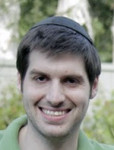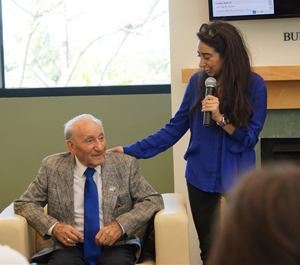Holocaust educator: ‘Never again’ means incorporating both national and local resources


LOS ANGELES — “Never again.” Those iconic words, widely used in the public discourse around the Holocaust, took a step toward codification under U.S. law with the House of Representatives’ recent passage of the Never Again Education Act on this year’s International Holocaust Remembrance Day.
If enacted into law, what would this proposal actually mean on a practical level? Jordanna Gessler, vice president of education and exhibits at the Los Angeles Museum of the Holocaust as well as a graduate of the University of Haifa’s Weiss-Livnat International MA Program in Holocaust Studies, provides her perspective in the following interview.
Q: The Never Again Education Act would expand the U.S. Holocaust Memorial Museum’s (USHMM) education programming to teachers nationwide. Does that represent an effective strategy for improving Holocaust education?
A: “For decades, Holocaust deniers have capitalized on confusing the public about historical facts such as the number of Jews who were murdered. Therefore, any strategy that offers additional Holocaust education resources to schools and teachers is necessary to combat Holocaust deniers and rising antisemitism.
“Although USHMM has a wide breadth of robust resources, schools should also look to local institutions for support, partnership, and programming to further this mission. This will allow for the formation of personal and customized programs that specifically target the needs of each state, city, and community. In-person professional training and development programs will be interactive and engaging for educators and will be crucial in establishing relationships with both local and national Holocaust museums so that participants continue to utilize our staff and tools as trusted resources for their students.”
Q: How does your museum use its resources to elevate the field of Holocaust education?
A: “Through teacher guides, teacher trainings, and online resources, Los Angeles Museum of the Holocaust provides a host of different ways that teachers can interact with the Holocaust and gain new information to share with their students. Our education philosophy is to engage students in learning this important history through primary sources and oral history, so many of our programs foster intergenerational dialogue and analysis of primary sources.
“One of the most comprehensive projects offered by the museum are case-study teacher guides that provide comprehensive information and tools needed to effectively teach the Holocaust in a class period through the lens of one survivor’s experience. These guides are intended to engage students in this important history through Holocaust survivor testimony and historical context to understand the past and build a more dignified future. The museum is working to reach more students by growing professional development for educators.
“For example, after the recent swastika incident involving students at a party in Newport Beach, we reached out to Newport Harbor High School and invited the students involved to turn what was a very bad decision into an opportunity for learning and healing. The students and their parents participated in a private tour of the museum, and listened to a 94-year-old Auschwitz survivor talk about her experiences.
Q: Does the Never Again Education Act adequately addresses the need to train the next generation of influential Holocaust educators?
A: “We are at a fateful moment in which any legislation that expands Holocaust education and public discussion on Holocaust history is a welcome development. Any actions our government takes to ensure that educational programs increase cultural literacy and awareness, and improve cross-cultural understanding and acceptance, are imperative even if they might be small steps at the moment.”
Q: How does Los Angeles Museum of the Holocaust implement that priority of countering antisemitism and all forms of bigotry?
A: “We recently expanded our gallery that focuses on the rise of Nazism, terror, and deception, which not only explores the hate symbols designed by the Nazis but further demonstrates and highlights those that have been appropriated by white supremacist groups today.
“For example, in 1920, Hitler designed a flag for the Nazi Party by combining the colors of the Imperial Germany flag (red, black, and white) and the symbol of the swastika, making it not only the most recognizable icon of Nazi propaganda but also a forceful symbol intended to elicit pride for an ‘Aryan identity’ and strike terror in Jews and others deemed by Nazis to be enemies. By the time Hitler was appointed chancellor in 1933, the connotations of the swastika had been forever changed. Since 1945 and outside of Asia, the swastika is the most notorious and significant of hate symbols, antisemitism, and white supremacy.
“Additionally, some right-wing nationalists in the U.S. use the slogan ‘Blood and Soil’ — mirroring the official Nazi policy which blamed the decline of Germany’s rural class on German Jews by depicting them as greedy bankers in contrast to the glorified, strong ‘Aryans’ who worked the land.
“It is vital for us to educate visitors and students on not only what happened in history, but what is going on today. These examples are demonstrative of the nexus between the Holocaust and current hate crimes.”
Q: Which of your educational experiences at University of Haifa resonate most powerfully today?
A: “The Weiss-Livnat program offered a plethora of opportunities for me to explore Holocaust history, social responsibility, cross-cultural environments, and the power of education. During my studies, we were fortunate to meet privately on several occasions with Yehuda Bauer, a prominent Israeli scholar of the Holocaust. There are two very impactful things I remember him saying. One was, ‘Suffering is suffering is suffering, and we cannot compare suffering.’ The other was that, ‘We should not be perpetrators, we should not be victims, and most importantly we should not be bystanders.’ These two points are incredibly powerful when considering today’s climate. Antisemitism is not just an assault on Jewish people, but on humanity. The Holocaust is not just Jewish history, but human history. We cannot stand silently by and allow others to be targeted based on their ethnicity, culture, gender, race, profession, or anything else.”
*
Jacob Kamaras, an associate with J Cubed Communications, is a former editor-in-chief of the Jewish News Syndicate. He resides in San Diego.
Brava, Bravo. This legislation and your input and ability to carry your intelligent program to the world is necessary historical education in fact and humanity. Thank you. Gloria Karp